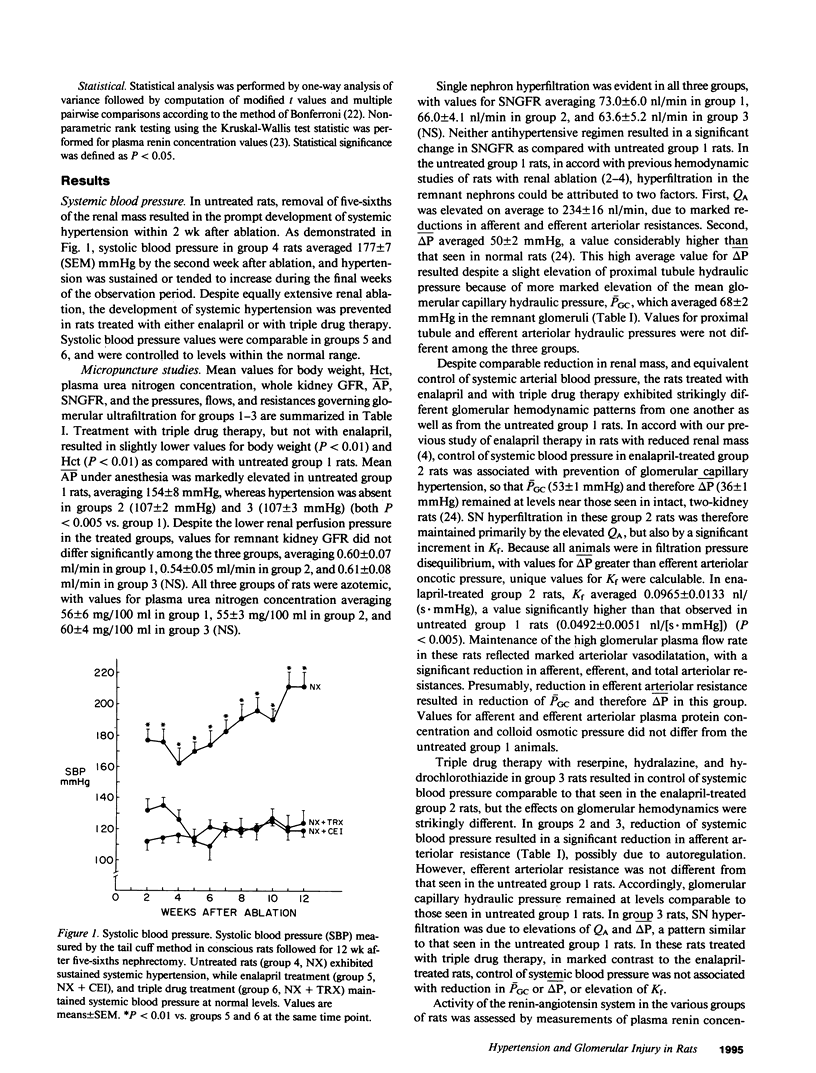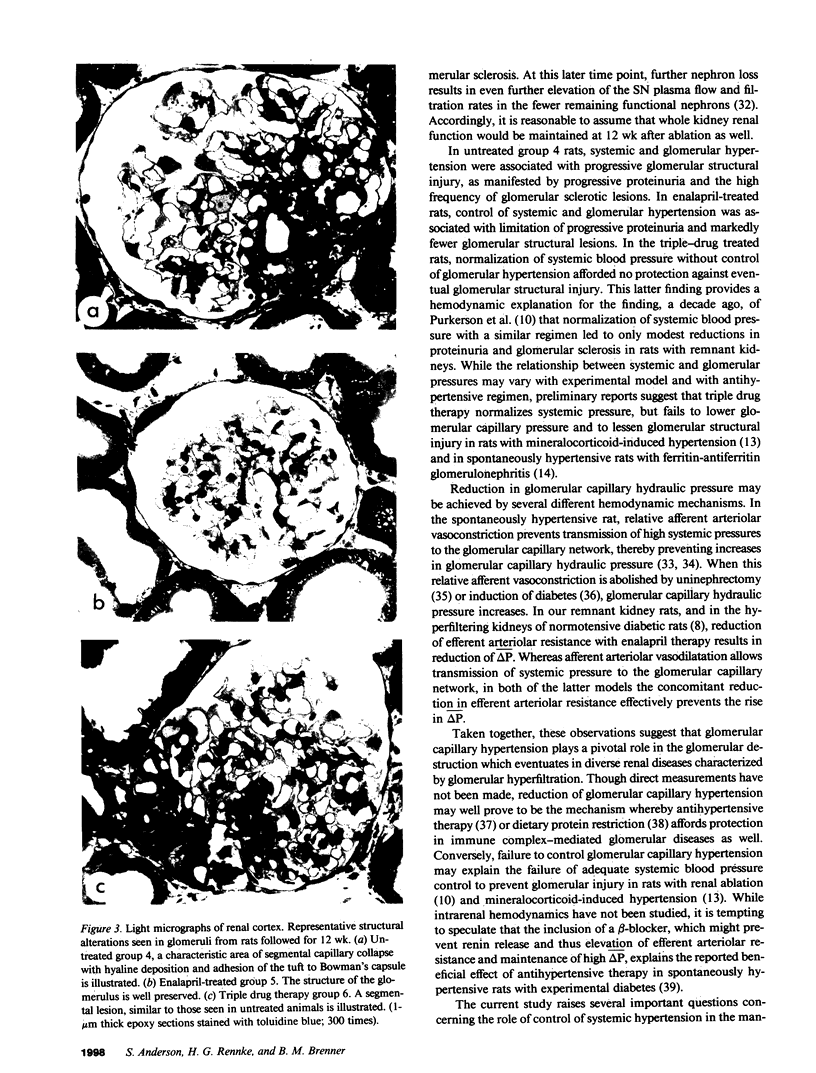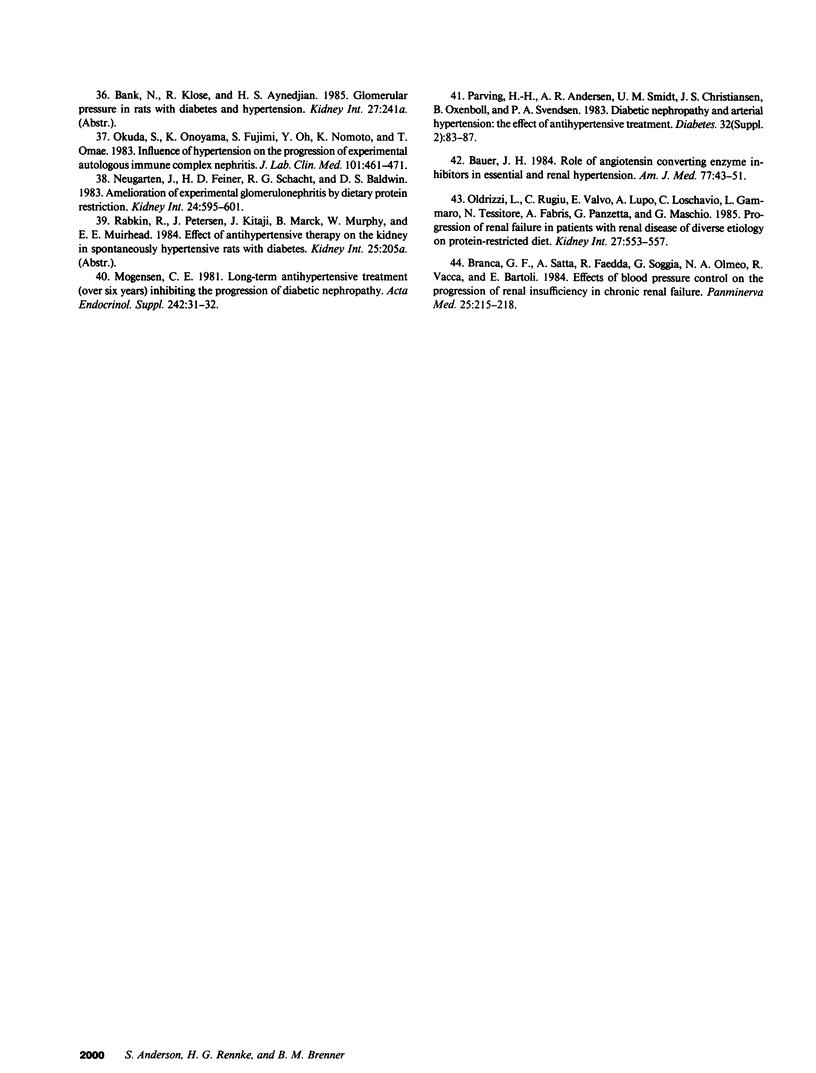Abstract
Micropuncture and morphologic studies were performed in six groups of male Munich-Wistar rats after removal of the right kidney and segmental infarction of two-thirds of the left kidney. Groups 1 and 4 received no specific therapy. Groups 2 and 5 were treated with the angiotensin I-converting enzyme inhibitor, enalapril, 50 mg/liter, in the drinking water. Groups 3 and 6 were treated with reserpine (5 mg/liter), hydralazine (80 mg/liter), and hydrochlorothiazide (25 mg/liter). All rats were fed standard chow. Groups 1-3 underwent micropuncture study 4 wk after renal ablation. Untreated group 1 rats exhibited systemic hypertension and elevation of the single nephron glomerular filtration rate (SNGFR) due to high average values for the mean glomerular transcapillary hydraulic pressure gradient (delta P) and glomerular plasma flow rate (QA). In group 2 rats, treatment with enalapril prevented systemic hypertension and maintained delta P at near-normal levels without significant reduction in SNGFR and QA. In contrast, triple drug therapy normalized systemic hypertension, but failed to lower delta P in group 3 rats. Groups 4-6 were followed for 12 wk after renal ablation. Untreated group 4 rats demonstrated continuous systemic hypertension, progressive proteinuria, and glomerular structural lesions, including mesangial expansion and frequent areas of segmental sclerosis. In group 5 rats, treatment with enalapril maintained systemic blood pressure at normal levels over the 12-wk period and dramatically limited the development of proteinuria and glomerular lesions. Despite equivalent systemic blood pressure control in group 6 rats, failure of triple drug therapy to control glomerular hypertension was associated with progressive proteinuria and glomerular lesions comparable to those seen in untreated group 4 rats. Thus, unless glomerular capillary hypertension is corrected, control of systemic blood pressure is insufficient to prevent progressive renal injury in rats with reduced renal mass.
Full text
PDF







Images in this article
Selected References
These references are in PubMed. This may not be the complete list of references from this article.
- Alhenc-Gelas F., Plouin P. F., Ducrocq M. B., Corvol P., Menard J. Comparison of the antihypertensive and hormonal effects of a cardioselective beta-blocker, acebutolol, and diuretics in essential hypertension. Am J Med. 1978 Jun;64(6):1005–1012. doi: 10.1016/0002-9343(78)90456-4. [DOI] [PubMed] [Google Scholar]
- Anderson S., Meyer T. W., Rennke H. G., Brenner B. M. Control of glomerular hypertension limits glomerular injury in rats with reduced renal mass. J Clin Invest. 1985 Aug;76(2):612–619. doi: 10.1172/JCI112013. [DOI] [PMC free article] [PubMed] [Google Scholar]
- Arendshorst W. J., Beierwaltes W. H. Renal and nephron hemodynamics in spontaneously hypertensive rats. Am J Physiol. 1979 Mar;236(3):F246–F251. doi: 10.1152/ajprenal.1979.236.3.F246. [DOI] [PubMed] [Google Scholar]
- Azar S., Johnson M. A., Iwai J., Bruno L., Tobian L. Single-nephron dynamics in "post-salt" rats with chronic hypertension. J Lab Clin Med. 1978 Jan;91(1):156–166. [PubMed] [Google Scholar]
- Azar S., Johnson M. A., Scheinman J., Bruno L., Tobian L. Regulation of glomerular capillary pressure and filtration rate in young Kyoto hypertensive rats. Clin Sci (Lond) 1979 Mar;56(3):203–209. doi: 10.1042/cs0560203. [DOI] [PubMed] [Google Scholar]
- Bauer J. H. Role of angiotensin converting enzyme inhibitors in essential and renal hypertension. Effects of captopril and enalapril on renin-angiotensin-aldosterone, renal function and hemodynamics, salt and water excretion, and body fluid composition. Am J Med. 1984 Aug 20;77(2A):43–51. doi: 10.1016/s0002-9343(84)80057-1. [DOI] [PubMed] [Google Scholar]
- Blantz R. C., Konnen K. S., Tucker B. J. Angiotensin II effects upon the glomerular microcirculation and ultrafiltration coefficient of the rat. J Clin Invest. 1976 Feb;57(2):419–434. doi: 10.1172/JCI108293. [DOI] [PMC free article] [PubMed] [Google Scholar]
- Branca G. F., Satta A., Faedda R., Soggia G., Olmeo N. A., Vacca R., Bartoli E. Effects of blood pressure control on the progression of renal insufficiency in chronic renal failure. Panminerva Med. 1983 Oct-Dec;25(4):215–218. [PubMed] [Google Scholar]
- Deen W. M., Maddox D. A., Robertson C. R., Brenner B. M. Dynamics of glomerular ultrafiltration in the rat. VII. Response to reduced renal mass. Am J Physiol. 1974 Sep;227(3):556–562. doi: 10.1152/ajplegacy.1974.227.3.556. [DOI] [PubMed] [Google Scholar]
- Deen W. M., Troy J. L., Robertson C. R., Brenner B. M. Dynamics of glomerular ultrafiltration in the rat. IV. Determination of the ultrafiltration coefficient. J Clin Invest. 1973 Jun;52(6):1500–1508. doi: 10.1172/JCI107324. [DOI] [PMC free article] [PubMed] [Google Scholar]
- Dworkin L. D., Feiner H. D. Glomerular injury in uninephrectomized spontaneously hypertensive rats. A consequence of glomerular capillary hypertension. J Clin Invest. 1986 Mar;77(3):797–809. doi: 10.1172/JCI112377. [DOI] [PMC free article] [PubMed] [Google Scholar]
- Dworkin L. D., Hostetter T. H., Rennke H. G., Brenner B. M. Hemodynamic basis for glomerular injury in rats with desoxycorticosterone-salt hypertension. J Clin Invest. 1984 May;73(5):1448–1461. doi: 10.1172/JCI111349. [DOI] [PMC free article] [PubMed] [Google Scholar]
- FUHR J., KACZMARCZYK J., KRUTTGEN C. D. Eine einfache colorimetrische Methode zur Inulinbestimmung für Nieren-Clearance-Untersuchungen bei Stoffwechselgesunden und Diabetikern. Klin Wochenschr. 1955 Aug 1;33(29-30):729–730. doi: 10.1007/BF01473295. [DOI] [PubMed] [Google Scholar]
- Hayslett J. P. Functional adaptation to reduction in renal mass. Physiol Rev. 1979 Jan;59(1):137–164. doi: 10.1152/physrev.1979.59.1.137. [DOI] [PubMed] [Google Scholar]
- Hostetter T. H., Olson J. L., Rennke H. G., Venkatachalam M. A., Brenner B. M. Hyperfiltration in remnant nephrons: a potentially adverse response to renal ablation. Am J Physiol. 1981 Jul;241(1):F85–F93. doi: 10.1152/ajprenal.1981.241.1.F85. [DOI] [PubMed] [Google Scholar]
- Maddox D. A., Price D. C., Rector F. C., Jr Effects of surgery on plasma volume and salt and water excretion in rats. Am J Physiol. 1977 Dec;233(6):F600–F606. doi: 10.1152/ajprenal.1977.233.6.F600. [DOI] [PubMed] [Google Scholar]
- Mogensen C. E. Long-term antihypertensive treatment (over six years) inhibiting the progression of diabetic nephropathy. Acta Endocrinol Suppl (Copenh) 1981;242:31–32. [PubMed] [Google Scholar]
- Neugarten J., Feiner H. D., Schacht R. G., Baldwin D. S. Amelioration of experimental glomerulonephritis by dietary protein restriction. Kidney Int. 1983 Nov;24(5):595–601. doi: 10.1038/ki.1983.199. [DOI] [PubMed] [Google Scholar]
- Neugarten J., Kaminetsky B., Feiner H., Schacht R. G., Liu D. T., Baldwin D. S. Nephrotoxic serum nephritis with hypertension: amelioration by antihypertensive therapy. Kidney Int. 1985 Aug;28(2):135–139. doi: 10.1038/ki.1985.132. [DOI] [PubMed] [Google Scholar]
- Okuda S., Onoyama K., Fujimi S., Oh Y., Nomoto K., Omae T. Influence of hypertension on the progression of experimental autologous immune complex nephritis. J Lab Clin Med. 1983 Mar;101(3):461–471. [PubMed] [Google Scholar]
- Oldrizzi L., Rugiu C., Valvo E., Lupo A., Loschiavo C., Gammaro L., Tessitore N., Fabris A., Panzetta G., Maschio G. Progression of renal failure in patients with renal disease of diverse etiology on protein-restricted diet. Kidney Int. 1985 Mar;27(3):553–557. doi: 10.1038/ki.1985.46. [DOI] [PubMed] [Google Scholar]
- Parving H. H., Andersen A. R., Smidt U. M., Christiansen J. S., Oxenbøll B., Svendsen P. A. Diabetic nephropathy and arterial hypertension. The effect of antihypertensive treatment. Diabetes. 1983 May;32 (Suppl 2):83–87. doi: 10.2337/diab.32.2.s83. [DOI] [PubMed] [Google Scholar]
- Pettinger W. A., Mitchell H. C. Renin release, saralasin and the vasodilator-beta-blocker drug interaction in man. N Engl J Med. 1975 Jun 5;292(23):1214–1217. doi: 10.1056/NEJM197506052922304. [DOI] [PubMed] [Google Scholar]
- Pfeffer J. M., Pfeffer M. A., Frohlich E. D. Validity of an indirect tail-cuff method for determining systolic arterial pressure in unanesthetized normotensive and spontaneously hypertensive rats. J Lab Clin Med. 1971 Dec;78(6):957–962. [PubMed] [Google Scholar]
- Purkerson M. L., Hoffsten P. E., Klahr S. Pathogenesis of the glomerulopathy associated with renal infarction in rats. Kidney Int. 1976 May;9(5):407–417. doi: 10.1038/ki.1976.50. [DOI] [PubMed] [Google Scholar]
- Raij L., Chiou X. C., Owens R., Wrigley B. Therapeutic implications of hypertension-induced glomerular injury. Comparison of enalapril and a combination of hydralazine, reserpine, and hydrochlorothiazide in an experimental model. Am J Med. 1985 Sep 27;79(3C):37–41. doi: 10.1016/0002-9343(85)90078-6. [DOI] [PubMed] [Google Scholar]
- Schor N., Ichikawa I., Brenner B. M. Glomerular adaptations to chronic dietary salt restriction or excess. Am J Physiol. 1980 May;238(5):F428–F436. doi: 10.1152/ajprenal.1980.238.5.F428. [DOI] [PubMed] [Google Scholar]
- Tucker B. J., Blantz R. C. Effects of glomerular filtration dynamics on the glomerular permeability coefficient. Am J Physiol. 1981 Mar;240(3):F245–F254. doi: 10.1152/ajprenal.1981.240.3.F245. [DOI] [PubMed] [Google Scholar]
- Viets J. W., Deen W. M., Troy J. L., Brenner B. M. Determination of serum protein concentration in nanoliter blood samples using fluorescamine or 9-phthalaldehyde. Anal Biochem. 1978 Aug 1;88(2):513–521. doi: 10.1016/0003-2697(78)90451-7. [DOI] [PubMed] [Google Scholar]
- Wallenstein S., Zucker C. L., Fleiss J. L. Some statistical methods useful in circulation research. Circ Res. 1980 Jul;47(1):1–9. doi: 10.1161/01.res.47.1.1. [DOI] [PubMed] [Google Scholar]
- Zatz R., Dunn B. R., Meyer T. W., Anderson S., Rennke H. G., Brenner B. M. Prevention of diabetic glomerulopathy by pharmacological amelioration of glomerular capillary hypertension. J Clin Invest. 1986 Jun;77(6):1925–1930. doi: 10.1172/JCI112521. [DOI] [PMC free article] [PubMed] [Google Scholar]
- Zatz R., Meyer T. W., Rennke H. G., Brenner B. M. Predominance of hemodynamic rather than metabolic factors in the pathogenesis of diabetic glomerulopathy. Proc Natl Acad Sci U S A. 1985 Sep;82(17):5963–5967. doi: 10.1073/pnas.82.17.5963. [DOI] [PMC free article] [PubMed] [Google Scholar]
- Zusman R. M. Renin- and non-renin-mediated antihypertensive actions of converting enzyme inhibitors. Kidney Int. 1984 Jun;25(6):969–983. doi: 10.1038/ki.1984.119. [DOI] [PubMed] [Google Scholar]



